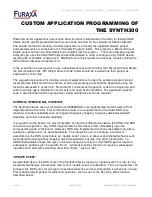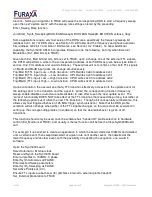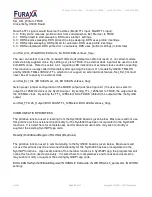
34 Canyon View Drive Orinda, CA., 94563 p:925.253.2969 f:925.253.4894
use either one of the TTL modulation or ARM/SWEEP inputs on an LVDSX2 device the user should:
Connect the internal push-on connector (connected to C79, in the case of boards with the HS clock
option, in which an external clock is not used) to the bottom pin (the pin closest to the PCI interface) on
the header for either MODA or MODB (JP1 or JP2), depending on which modulation input is desired
(see modulation input section). Boards with both the HS option and the LVDSX2 option are factory-
default-configured with this push-on connector connected to the TRIG/MODB jumper, thereby enabling
the “EXT CLK IN” SMA jack to control the TRIG/MODB input.
Connect the TTL modulation input to the “EXT CLK IN” SMA jack. In this case, jumper JP3 (1GHz
clock out) must NOT be installed.
If the second TTL modulation input is also required, it may be connected to the bottom pin of the other
of jumper JP1 or JP2.
Alternatively, the LVDSX2 option may be removed completely, if not needed, by completely unsoldering
IC U6, and installing the appropriate jumpers on JP1 and JP2, to allow the TRIG/MODA and
TRIG/MODB jacks to be used as TTL modulation inputs.
LED INDICATORS
There are three Red/Green LEDs on the top edge of the SYNTH300 board that are useful during
system integration for monitoring the board status. The functions of the LEDs are outlined below.
EXT CLK LED
For board models in which an external clock input is available, when the board is configured for an
external system clock (see section 9.3) the Ext Clk LED illuminates, and is used to indicate the status
of the externally supplied clock, as follows:
RED:
Indicates insufficient clock frequency. Clock frequency is < 200MHz
GREEN:
Indicates healthy clock frequency. Clock frequency is > 235MHz
If the clock frequency is between 200 and 235 MHz, the LED will partially light GREEN and partially
light RED, appearing as Orange or Yellow, indicating marginal clock frequency.
ARM SWEEP LED
This LED is useful when using externally controlled frequency sweeping operation, with the
set_arm_write function enalbed. Refer to the supplied example program (example.cpp) for further
information regarding this application. If external modulation is selected and the Set Arm Write (refer
to section 9.3) capability is enabled, the LED will indicate the following:
GREEN:
The board is ARMED for frequency sweeping (sweep not active)
RED:
The board is performing a frequency sweep (sweep active)
OFF:
The board is in a post-sweep dwell (sweep not active)
Mixed (yellow): The board is in a pre-sweep dwell (sweep not active)
NOTE: ARM/Sweep operation is not available when CN4 and CN5 are used for LVDSA outputs.
r1v06
Page 10 of 31
Copyright © 2008 – 2010 Furaxa Inc.





























